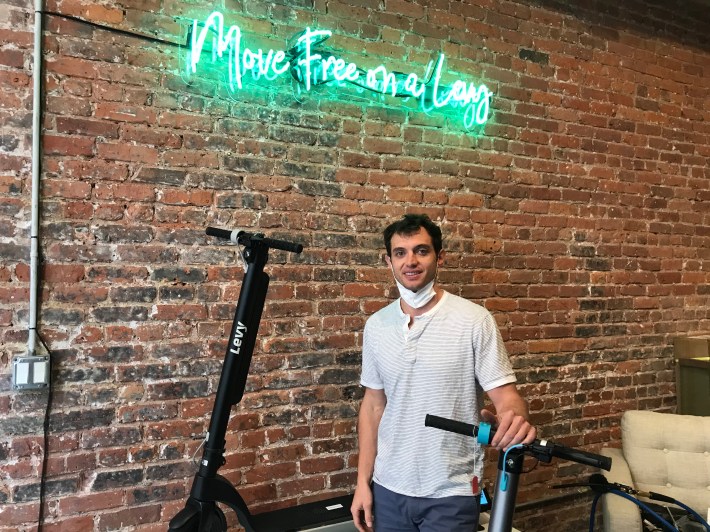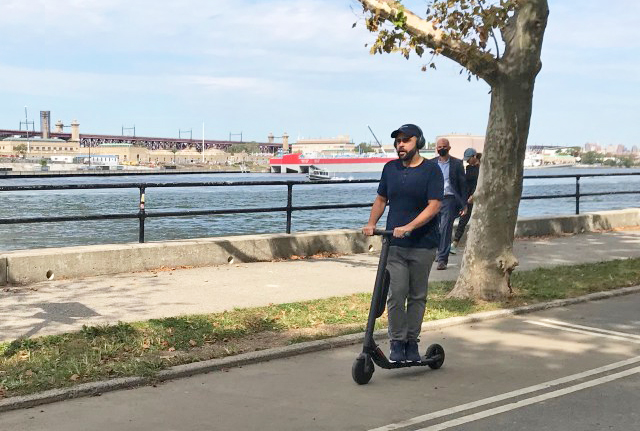We're going to need bigger bike lanes.
As New York City gets ready to set up corporate scooter-share programs outside of Manhattan, sales of privately owned e-scooters are skyrocketing by triple digits in the five boroughs, adding another transportation mode to the city's increasingly congested bike lanes.
Amid the spike in sales of the light electric transportation option, advocates are warning that the city is running out of room to handle the additional traffic. The potential for conflict is obvious.
Visit any of the East River bridges and the already narrow bike and pedestrian paths are filled with multiple modes of transportation — legs, bikes, electric bikes, scooters and e-scooters — moving at different speeds. On a recent Friday on the Manhattan Bridge, Streetsblog spotted several e-scooter riders on the bike path, including a father guiding his child on a traditional three-wheeled kid's scooter. Every day on the Queensboro Bridge, a single narrow lane is used by walkers, cyclists and scooter riders in both directions. Crashes occur daily.
Concerns over scooter-share programs tend to focus on the question of where to park the dockless devices, which have cluttered sidewalks in other cities. But that concern ignores the bigger one: New York City also doesn't have the infrastructure to handle an explosion of new non-car transportation options. The increasing interest in e-scooters as a way to get around New York, even before companies like Bird and Lime can start local scooter-share programs, is putting stress on the city's bike infrastructure, which was already creaking under an uptick in people on bikes.
"When Bird or Lime gets here, it's going to explode in terms of usage. What I worry about is too many of these on the streets and not enough space to ride them. It's been nice for people this summer, there's plenty of space to ride," said Eric Levenseller, the founder of New York City-based scooter company Levy Electric Scooters. "People will probably move out of the bike lanes and get into regular traffic lanes because there's not enough space or they don't feel safe in the bike lane."
Some intrepid scooter users are already making that decision, like this pair recently seen scooting in the motor vehicle lanes on the Williamsburg Bridge.
Individual owners of scooters and other micro mobility devices are loving the ride, even if they miss the bigger picture.
"I've had this for three, four months now," Brian Bonet said about his Segway scooter on a recent September afternoon after he rode across the Manhattan Bridge. "I take it to Borough Park and back. I live all the way on the Upper West Side, this thing goes around 28 miles in range. I just crossed the bridge all the way from Borough Park."
Scooter riders had been an occasional sight on streets, bike lanes and bridges before the electric rides were legalized generally in the state budget and then by the City Council in 2020, and they've become an even more frequent presence since legalization.
Scooter companies and retailers are reporting an uptick in interest as well this year, driven by both the change in law and a population that remains wary of public transportation. A spokesperson for e-scooter company Unagi said that New York City sales of its product through the company's website increased 312 percent in the second quarter of 2020 compared to the first quarter, and 549 percent comparing the second quarter of 2020 with the second quarter in 2019. The spokesperson also said that the company's national sales have gone from hundreds of scooter sales per month to thousands.
Local retailers say they've seen the same kind of interest.
"A lot of people are coming in who've never owned a bicycle, but are looking for alternative modes of transportation," said Levenseller. "A lot of people are using them that have to go back into work and don't want to take the subway.
"Business has definitely picked up significantly since April," Levenseller added during a chat in Levy's Lower East Side storefront, claiming a 160-percent year-over-year increase since scooters were legalized statewide in April.

A few blocks north at Paragon Sports, sales clerk Julian Maerwitz said that sales on Unagi scooters were brisk since the store was able to restart its retail operations during the summer.
"We've sold a lot of these as the demand picked up from COVID," he said, putting the number of scooters sold at around 30. "They sell almost immediately as they come in."
Scooter riders around Manhattan ranged from the experienced riders to newbies, but both times said that they chose e-scooters in order to avoid the bus and subway.
"None of us wants to take the subway so we're either getting electric bikes or scooters," a scooter user named Jae, who declined to give her last name, said about her and her co-workers in the Meatpacking District. "I've definitely seen more people on these since I bought my first one three years ago."
Sebastian Brecht, a chef in the East Village, said he switched from a bike to a scooter to commute from Crown Heights.
"I was riding my bike for many months but it was hard on my body," he said. "I did not want to buy an electric bike because you're still sitting down on it, and I don't like going on public transportation. I haven’t been on it in five months or more."
Advocates say they welcome any new transportation option that gets people out of cars, but that the city government has to start thinking about the bike and scooter traffic of tomorrow, instead of the traffic patterns of the past.
"Designing bike lanes for the traffic we had in the 2010s soon won't be enough to handle the bike traffic of the 2020s," said Transportation Alternatives spokesman Joe Cutrufo "The number of people getting around on two wheels has shot up, not just with the pandemic-fueled bike boom, but the continued growth of Citi Bike, and soon scooter share. The next administration will need to expand not only the network of protected bike lanes, but also the width of protected bike lanes."
More scooter users doesn't just have to be a conflict point for pedestrians and people on bikes though. As former Lime Bike Chief Programs Officer Scott Kubly pointed out to Streetsblog in 2018, scooter riders will eventually be like bike riders — and demand more space for their sustainable transport mode.
"If scooters have a lower barrier than bikes, but riders want the same protection that bikers do, doesn’t that build a larger constituency for better bike lanes?" Kubly rhetorically asked.
Two years later, scooter retailers and riders are echoing that 2018 prediction.
"In the long term cities need to think about having different lanes for lightweight electric vehicles like this, especially if they're going to be going faster than bikes," said Levenseller.
Bonet, who said that he rides his scooter in Midtown, said that the existing bike lanes in Midtown were hazardous already, and that the small bit of the curb being taken away from cars was also complicating things for riders.
"Sixth Avenue and Eighth Avenue, those are busy commercial streets and they get kind of difficult to navigate when people are parked in the bike lane, walking in the bike lane. And these new outside diner pop up things that take up parking spaces and bike lanes as well, it's kind of a hassle, so maybe a little more room would be nice," he said.
Multiple City Council members have expressed interest or support for scooter share in recent years, but the City Council still hasn't had much in the way of a discussion about making the streets safe for scooter users. Queens Council Member Costa Constantinides expressed support for micro-mobility lanes and the idea of tilting the streets from car dominance to something more bike and light electric-friendly, while he watched Bird scooter demo held at Astoria Park in late September.
"It's a good problem to have that we have too many people using the bike lanes, but multimodal transportation requires us to do more," Constantinides said. "I'm not opposed to that at all. As someone who just went through a summer where my lungs were weak from COVID and the doctors said, 'Go out for a walk' when it was 95 degrees every day with oppressive humidity, where was I going to go? We're living in climate change now, and if we don't act to create options for emissions-free transportation, what are we doing?"






